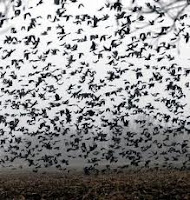 |
| Sts. Benedict & Scholastica |
The most famous of our saints is our founder
ST. BENEDICT of NORCIA (d. 547).
He was born to the Roman nobility and was the twin brother of
St. Scholastica (mentioned in our previous blog). As a youth he studied in Rome, but was dismayed by the lack of discipline and the worldly attitude of his fellow students. He fled to the mountains near Subiaco (about 2 hours north of Rome), living as a hermit in a cave for three years where he was befriended by a
raven who fed him. His discipline was such that an attempt was made on his life; some monks tried to poison him, but he gave the foul bread to his
raven to dispose of.
He returned to his cave, but continued to attract followers, eventually establishing twelve monasteries.
He later founded the monastery at Monte Cassino, where he wrote the Rule of our Order. He had the ability to read consciences, the gift of prophesy, and could forestall attacks of the devil.
 |
| (Lu Bro) | | | | | | | | | |
|
|
|
A summation of the Rule: “Pray and Work” is balanced by attention to manual labor, intellectual pursuit and prayer. He is one of the patrons of modern Europe.
 |
| (One of my favorite images: statue at St. Martin's Abbey, Lacey, WA) |
The
raven is a symbol for solitude. It also symbolizes filial gratitude and affection, wisdom, hope, longevity, death, and fertility.
Another great Benedictine saint, but not well known in America is
ST. MEINRAD
(d. 861). He is known as the
Martyr of Hospitality.

He was a monk in the monastery at Bollingen (Switzerland) though he longed to become a hermit, living a life of prayer, penance and meditation. In 828 having at last obtained his superiors' permission, he set off for the Dark Wood on the slopes of Mount Etzel.
Soon after settling in a solitary retreat he found a nest with two young
ravens, which he gladly adopted and tamed, perhaps because the he had a statue of the Child Jesus holding a small
bird in one hand. St. Meinrad spent seven years on this mountain, but as more and more pilgrims come to visit him, he fled from his tiny cell, taking his two friends, the
ravens, with him.
 |
| Br. Martin Erspamer, OSB |
|
|
|
He went still farther into the depths of the Dark Wood until one day he found, in the midst of the lofty pine trees on a small table-land surrounded by hills on three sides, a bubbling spring giving forth sparkling, fresh mountain water. Here he built himself a little log hut and a chapel, in which he reverently placed his statue. His faithful
ravens often perched on either side of a crucifix, watching the holy hermit as he worked and prayed.
He spent over 20 years alone and was never harmed by the mountain bears or wolves or other wild animals who dwelt there. However, two hardened criminals, hearing that people made pilgrimages to the hermit, were tempted by the idea that he must have rich treasure hidden away in his lonely hermitage. And so one cold winter night they made their way through the deep snow to his retreat in the forest.
As the saint was finishing his Mass he heard the shrill screams of warning of his faithful
ravens. He went out and welcomed the two men with loving kindness and hospitality, setting before them some bread and wine. When they roughly demanded that he show them his hidden treasure he humbly led them into the little chapel, and pointing to the plain wooden statue above the altar, he said, "I have no other treasure."
In a mad rage the two robbers seized and brutally beat the saintly old hermit to death with a heavy club, while his two
ravens flew wildly about, screaming and trying in vain to help their good friend by pecking at the murderers' heads.
The men dragged the saint's body away and were about to begin their search for the supposedly hidden treasure when they noticed a wondrous smell pervading the place. When they perceived that two candles standing by the hermit's bed had somehow just been lighted, without human hand, the two assassins fled in terror all the way to Zurich. But like the accusing finger of God, Meinrad's two
ravens persistently followed and attacked the murderers until they were arrested and confessed the crime.
On the place where he was martyred a church and shrine were built in his memory, which later became the famous and very beautiful Abbey of Einsiedeln. I was able to visit this marvelous monastery and the Black Madonna, when I lived in Germany over 40 years ago.


















































